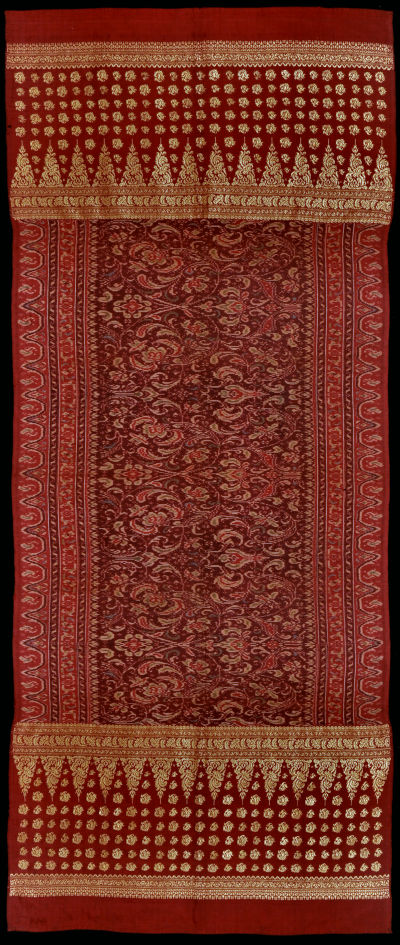| |
 
 | | | |
069 Sumatra, Bangka
Limar (shawl)  
| | Locale: | Malay people. Probably Muntok village on Bangka, else from Palembang. | | Period: | 18th to mid 19th c. | | Yarn: | Silk, hand-spun | | Technique: | Weft ikat | | Panels: | 1 | | Size: | 83.5 x 200 cm (2' 8" x 6' 6") LW: 2.40 | | Design: | Kain limar, shoulder cloth in fine silk. Ikated central field, badan, with the Gaja Mada motif, elaborately framed in songket, supplementary weft with gold thread. Tumpal style end borders. | | Comment: | Outstanding example of the traditional high status shoulder cloth of this region. Very similar to the limar made in Palembang on Sumatra. The touches of blue and green in this example make clear that it is not from Palembang but from Bangka. Several tiny holes (abt. 1x1 mm), not affecting the overall visual impact. Two small repairs: one abt.. 4x40 mm made by gluing to the back a fragment from another limar cloth, the other, about 10x5 mm by means of fine needlework. | | Background: | Chapters on Sumatra and Bangka. | | Exhibited: | Museu do Oriente, Lisbon, 2014/15.
Hong Kong University Museum and Art Gallery, 2017. | | Published: | Woven Languages, 2014..
Ikat Textiles of the Indonesian Archipelago, 2018.
| | Compare: | 070 147 205 | | Sources: | Near identical to 18th-early 19th C. limar identified as Palembang in Yale Art Gallery, Nr. 1937.5434. Very similar to Bangka limar in Hunt and Kahlenberg, Five Centuries of Indonesian Textiles, p. 94; and to one in Brinkgreve and Stuart-Fox, Living with Indonesian Art, Fig. 98. Very similar to National Gallery of Australia NGA2000.904, also to NGA2000.870, and Boston Museum of Fine Arts, Nr. 30.821. Also similar to limar in Khan Majlis, Wege zu Goettern und Ahnen, Fig. 110, 114, 116; and in Gittinger, Splendid Symbols, Fig. 65. | | |

©Peter ten Hoopen, 2025
All rights reserved.
|
|


